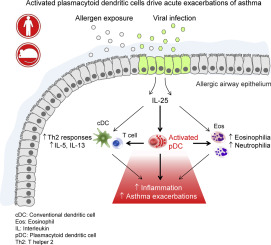Journal of Allergy and Clinical Immunology ( IF 11.4 ) Pub Date : 2017-10-17 , DOI: 10.1016/j.jaci.2017.08.032 Aikaterini-Dimitra Chairakaki 1 , Maria-Ioanna Saridaki 1 , Katerina Pyrillou 1 , Marios-Angelos Mouratis 1 , Ourania Koltsida 2 , Ross P Walton 3 , Nathan W Bartlett 4 , Athanasios Stavropoulos 1 , Louis Boon 5 , Nikoletta Rovina 6 , Nikolaos G Papadopoulos 7 , Sebastian L Johnston 3 , Evangelos Andreakos 1

|
Background
Although acute exacerbations, mostly triggered by viruses, account for the majority of hospitalizations in asthmatic patients, there is still very little known about the pathophysiologic mechanisms involved. Plasmacytoid dendritic cells (pDCs), prominent cells of antiviral immunity, exhibit proinflammatory or tolerogenic functions depending on the context, yet their involvement in asthma exacerbations remains unexplored.
Objectives
We sought to investigate the role of pDCs in allergic airway inflammation and acute asthma exacerbations.
Methods
Animal models of allergic airway disease (AAD) and virus-induced AAD exacerbations were used to dissect pDC function in vivo and unwind the potential mechanisms involved. Sputum from asthmatic patients with stable disease or acute exacerbations was further studied to determine the presence of pDCs and correlation with inflammation.
Results
pDCs were key mediators of the immunoinflammatory cascade that drives asthma exacerbations. In animal models of AAD and rhinovirus-induced AAD exacerbations, pDCs were recruited to the lung during inflammation and migrated to the draining lymph nodes to boost TH2-mediated effector responses. Accordingly, pDC depletion after allergen challenge or during rhinovirus infection abrogated exacerbation of inflammation and disease. Central to this process was IL-25, which was induced by allergen challenge or rhinovirus infection and conditioned pDCs for proinflammatory function. Consistently, in asthmatic patients pDC numbers were markedly increased during exacerbations and correlated with the severity of inflammation and the risk for asthma attacks.
Conclusions
Our studies uncover a previously unsuspected role of pDCs in asthma exacerbations with potential diagnostic and prognostic implications. They also propose the therapeutic targeting of pDCs and IL-25 for the treatment of acute asthma.
中文翻译:

浆细胞样树突状细胞驱动哮喘急性发作
背景
尽管主要由病毒引发的急性发作占哮喘患者住院的大部分,但对所涉及的病理生理机制仍然知之甚少。浆细胞样树突状细胞 (pDC) 是抗病毒免疫的重要细胞,根据具体情况表现出促炎或致耐受性功能,但它们在哮喘急性发作中的作用仍未得到探索。
目标
我们试图研究 pDC 在过敏性气道炎症和急性哮喘发作中的作用。
方法
过敏性气道疾病 (AAD) 和病毒诱导的 AAD 恶化的动物模型用于剖析体内pDC 功能并解开所涉及的潜在机制。进一步研究来自病情稳定或急性发作的哮喘患者的痰液,以确定 pDC 的存在以及与炎症的相关性。
结果
pDC 是导致哮喘恶化的免疫炎症级联反应的关键介质。在 AAD 和鼻病毒诱导的 AAD 恶化的动物模型中,pDC 在炎症期间被募集到肺部并迁移到引流淋巴结以增强 T H 2 介导的效应反应。因此,过敏原攻击后或鼻病毒感染期间pDC耗竭消除了炎症和疾病的恶化。这一过程的核心是 IL-25,它由过敏原攻击或鼻病毒感染诱导,并调节 pDCs 的促炎功能。一致地,在哮喘患者中,pDC 数量在恶化期间显着增加,并且与炎症的严重程度和哮喘发作的风险相关。
结论
我们的研究揭示了 pDC 在哮喘急性发作中具有潜在的诊断和预后意义的先前未曾预料到的作用。他们还提出了以 pDC 和 IL-25 为治疗靶点来治疗急性哮喘。











































 京公网安备 11010802027423号
京公网安备 11010802027423号